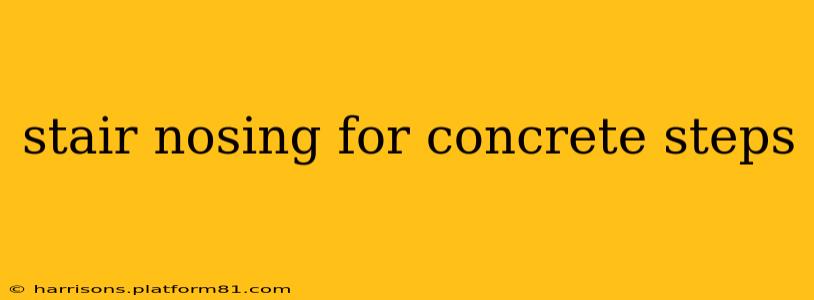Concrete steps, while durable and long-lasting, can often lack the safety and aesthetic appeal of other materials. This is where stair nosing comes in. Adding stair nosing to your concrete steps provides a significant upgrade in both safety and curb appeal. This guide will delve into the various aspects of choosing, installing, and maintaining stair nosing for concrete steps.
What is Stair Nosing?
Stair nosing refers to the protective and decorative covering applied to the edge of a stair tread. For concrete steps, this provides crucial safety features by preventing slips and falls, as well as adding a touch of elegance to your outdoor or indoor space. It's more than just a cosmetic addition; it's a vital safety element, particularly important in high-traffic areas or for homes with children and elderly residents.
Types of Stair Nosing for Concrete Steps
Several materials and styles are available for concrete stair nosing, each offering distinct advantages and disadvantages:
Aluminum Stair Nosing:
- Pros: Durable, relatively inexpensive, comes in various colors and finishes, easy to install.
- Cons: Can be prone to scratching and denting over time, may not be as aesthetically pleasing as other options for high-end projects.
Steel Stair Nosing:
- Pros: Extremely durable, resistant to damage, offers superior safety features due to its strength.
- Cons: More expensive than aluminum, can rust if not properly treated, requires more precise installation.
Rubber Stair Nosing:
- Pros: Provides excellent slip resistance, ideal for high-traffic areas, available in various colors and thicknesses, absorbs impact.
- Cons: Can wear down over time, may not be as aesthetically pleasing as other options for some design styles.
PVC Stair Nosing:
- Pros: Affordable, easy to install, comes in various colors and designs, relatively durable.
- Cons: Not as durable as metal options, can fade or crack under intense sunlight.
Stone Stair Nosing:
- Pros: Elegant and sophisticated look, durable and long-lasting, enhances the aesthetic appeal of your steps significantly.
- Cons: Expensive, requires professional installation, heavier and more difficult to work with than other materials.
How to Choose the Right Stair Nosing?
The best stair nosing for your concrete steps depends on several factors:
- Budget: Aluminum and PVC are generally the most affordable, while stone and steel are at the higher end.
- Traffic: High-traffic areas benefit from durable materials like steel or rubber.
- Aesthetic Preferences: Consider the overall design of your home or building to choose a style that complements the existing architecture.
- Climate: In harsh climates, consider materials resistant to extreme temperatures, moisture, and UV rays.
- Safety Requirements: Prioritize slip-resistance, especially in areas with potential hazards.
What are the Benefits of Adding Stair Nosing to Concrete Steps?
- Enhanced Safety: Stair nosing provides a non-slip surface, reducing the risk of falls, especially on wet or icy steps.
- Improved Aesthetics: It can transform the look of your concrete steps, adding a polished and professional finish.
- Increased Durability: It protects the edges of your concrete steps from wear and tear, extending their lifespan.
- Added Value to Your Property: Upgraded steps increase the overall curb appeal and value of your home.
How Much Does Stair Nosing Cost?
The cost of stair nosing varies significantly based on the material, size, and complexity of the installation. Aluminum is usually the cheapest option, while stone can be quite expensive. Installation costs also factor into the total price; professional installation is usually recommended for stone and steel nosing.
How to Install Stair Nosing on Concrete Steps?
While some types of stair nosing are relatively easy to install yourself (like certain PVC or rubber options), professional installation is strongly recommended for materials like stone and steel to ensure proper fit and longevity. Incorrect installation can compromise safety and aesthetics.
What is the Best Material for Outdoor Concrete Steps?
For outdoor concrete steps, materials that are weather-resistant, slip-resistant, and durable are crucial. Aluminum with a powder-coated finish, steel, or rubber are excellent choices for outdoor applications, offering protection against the elements.
How Long Does Stair Nosing Last?
The lifespan of stair nosing depends on the material and the level of traffic and exposure to the elements. Durable materials like steel and stone can last for many years, even decades, with proper maintenance. Other materials might require replacement sooner.
By carefully considering these factors, you can choose the perfect stair nosing to enhance the safety, aesthetics, and value of your concrete steps. Remember that investing in high-quality materials and professional installation will ensure a longer-lasting and more effective solution.
